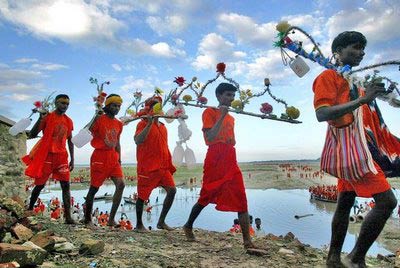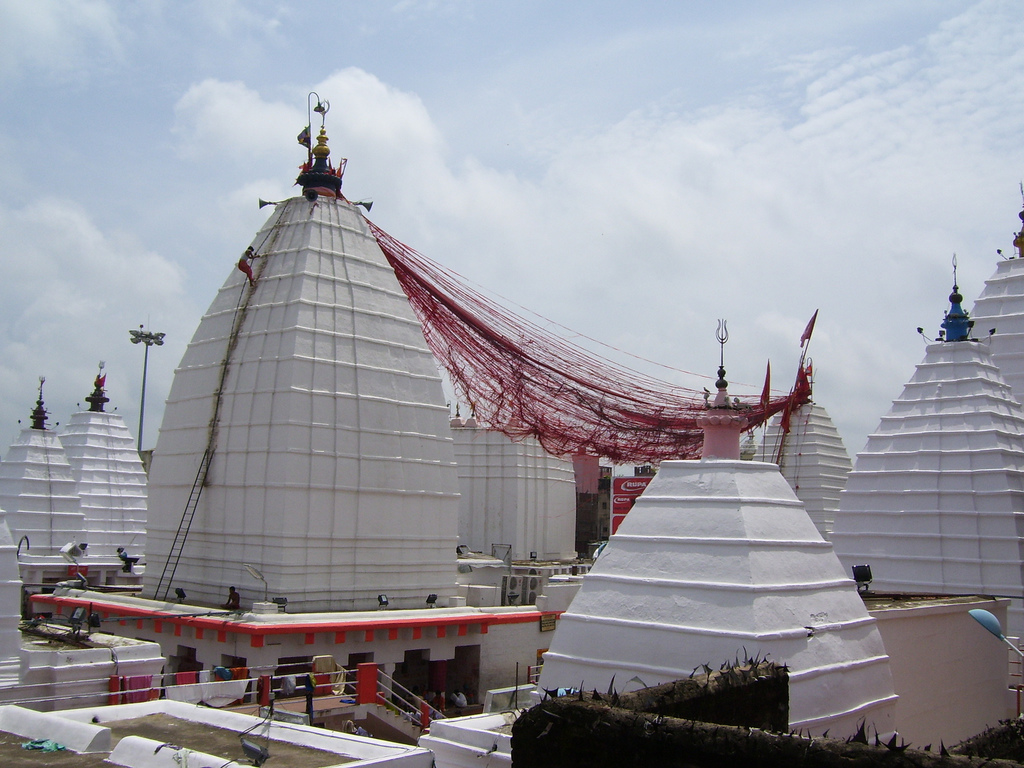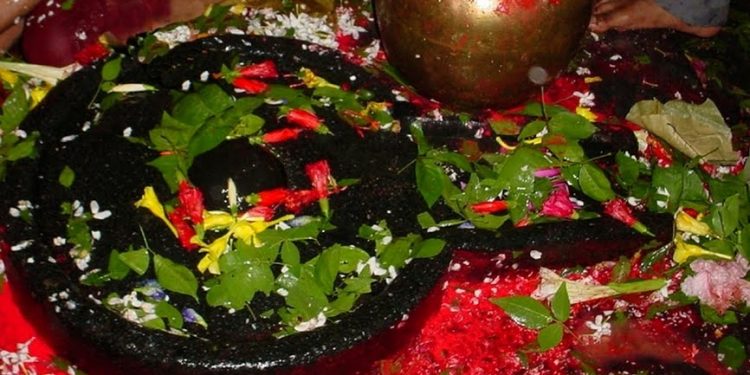Baba Baidyanath temple complex consists of the main temple of Baba Baidyanath, where the Jyotirlingam is installed, is at Deoghar in Jharkhand. Ravana offered his ten heads one after the another to Shiva as a sacrifice
Shrine’s History
The history of Babadham has been derived from various manuscripts and also the inscriptions at various places in the Temple area. In the 8th century A.D., the last Gupta Emperor Adityasena Gupta ruled this region. The Babadham temple has been famous since then. When Mugals began to rule India, the temple of Babadham was under their tributory rulers.
The most important literary source on the history of medieval Babadham is Aine – Akbari. During Akbar’s rule Man Singh was associated with Akbar’s court. Man Singh remained attached to the Gidhaur dynasty for a long time and had contacts with a number of rulers of Bihar. Man Singh’s brother, Bhan Singh was married to daughter of Puran Mal. Man Singh’s interest in Babadham seems to have been determined by his love for this holy shrine because he then got a tank excavated, which is today known as Mansarovar. The Madan Madhavi, a manuscript preserved in the archives of Maharaja of Gidhaur, provides information related to the political and cultural history of Gidhaur Raj. It includes a description of Babadham as well. Puran Mal’s inscription proves his connection with the Babadham temple.
An inscription on the Baidyanath temple states that he built it at the request of the priest Raghunath Ojha. Tradition relates that the inscription was forcibly put by Puran Mal, after he had the temple repaired, to mark his ownership of the surrounding land. Raghunath Ojha was displeased with the inscription, but was unable to resist Puran Mal. Hence, after Puran Mal was gone, he had a porch created and therein set his own inscription. The legend states that the priest fasted for some days at the gate of Baidyanath who revealed to him in a dream that he should build a new porch and set up an inscription. But he claims the credit of having created the entire temple. Pilgrimage to Baidyanath was well recognized in the Muslim period as well. There is an interesting account of the pilgrimage to Baidyanath in the Khulasati-t-twarikh written between 1695 and 1699 A.D. In the district of Munger on the skirts of the hill, there is a place named the Jharkhand of Baijnath (Baidyanath) sacred to Mahadeva.
From the writings of Khulasati-t-twarikh it is evident that the importance of Babadham temple has been well admitted by all. In the 18th century, the Maharaja of Gidhaur faced political turmoil. He had to fight against the Nababs of Birbhum. Under the Muhammadan government, the chief priest appears to have paid a fixed rent to the Nabab of Birbhum, and the administration of the temple seems to have been left entirely in the hands of the priest. For a few years the Nabab ruled over Babadham. Subsequently, the Maharaja of Gidhaur defeated the Nabab and Babadham was brought back under his rule till the East India Company came in. In 1757 after the battle of Pallsy the officers of the East India Company paid their attention to this temple.
An English man, Keating was sent to look at the administration of the temple. Mr. Keating, the first English collector of Birbhum, took interest in the administration of the temple. In 1788, under Mr. Keating’s order Mr. Hesilrigg, his assistant, who was probably the first English man to visit the holy city, set out to supervise personally the collection of the pilgrim offerings and dues. Later, when Mr. Keating himself visited Babadham, he was convinced and forced to abandon his policy of direct interference. He handed over the full control of the temple to the hands of the high priest.

Legends Associated with This Shrine
One legend, according to Shiva Purana is that in the Treta Yuga the deamon Ravana, king of Lanka , propitiated Lord Mahadeva and wanted him to come over to Lanka. Mahadeva did not agree to his prayer but told Ravana that one of the twelve emblems of his divinity, Jyotirlinga, would be quite as effective as his presence and that he might take it away on the condition that there should be no break in the journey back to Lanka and the lingam would not be deposited anywhere on the earth.
The condition was that if the lingam were put anywhere on the earth in the course of the journey, it would be fixed to that spot forever. The legend is that Ravana agreed to this condition and took the lingam and started his journey back to Lanka. The gods dreaded the effect of the lingam being established at the seat of the deamon king. A ruse was devised and Varuna, the god of the waters, entered the stomach of Ravana and the deamon had to descend to earth to relieve him. Later, Vishnu, in the garb of an old Brahmin, appeared before Ravana, after his descent to the earth, and began to converse with him. Unaware of the trick,
Ravana requested the Brahmin to hold the Jyotirlinga for a few minutes so that he could relieve himself. Lord Vishnu readily agreed to it and, as soon as Ravana turned his back to relieve himself, he left the Jyotirlinga on the spot and vanished. When Ravana came back, he found that the Jyotirlinga was firmly fixed to the earth and realized that a trick had been played on him. Out of frustration, he pressed it with his thumb so it went inside and got tilted slightly. However, failing to remove the lingam, he made his obeisance to the lingam and daily he used to come from Lanka and worship the divinity. The spot where Ravana came down to the earth has been identified with Harila Jori, about four miles north of Babadham and the place where the lingam was deposited is known as Babadham. The present nomenclature of the lingam is Baidyanath Jyotirlingam, and there is a legend about it. According to the Padma Purana, a Brahmin in the garb of Lord Vishnu, after taking the lingam from Ravana, consecrated it in due form with water from a neighboring tank.
This tank is known as Shivaganga today.
There was a Bhil present, who was instructed as to what should be done. The Bhil had informed Ravana as to the disappearance of the Brahmin. Ravana is supposed to have excavated a well with an arrow and brought into it the waters of all the sacred pools of the earth. This well is known as Chandrakoopa today. It is said that the lingam, after the death of Ravana, used to be worshipped by a hunter Baiju, and the lingam came to be known by Baiju’s name as Baidyanath. The story of Baiju giving rise to the name of Baidyanath is more prevalent as a Santhal tradition.
There is another legend to the effect that in the Satya Yuga when Sati, the consort of Shiva and daughter of Daksha, committed suicide because of the discourtesy showed towards her husband by Daksha in not inviting him to a Yajna, Lord Shiva stuck the corpse of his wife on the point of his trident and roamed about in a frenzy of fury. Lest Shiva’s anger and frantic movements should destroy the world, Vishnu cut the dead body with his discus into fifty-two parts, which fell in different parts of India and became Mahapithasthans. According to the legend, the heart of Sati fell at Babadham. Hence, the name Hridayapeeth. There is, however, no shrine to commemorate this occurrence.
Another legend is that, in the first age of the world, Lord Shiva manifested himself as a lingam of light at twelve different places under different names, and Baidyanath was one of those twelve places. Sati worshipped the emblem in the form of a pandanus flower on the top of the lingam and dwelt for a long time in a grove close by in order to worship it. This place is called Ketakivana. Matsya Purana narrates about the sanctity of the holy place where Shakti lives and frees people from diseases, i.e., Arogya Baidyanathitee. It signifies that Baidyanath cures people from incurable diseases with the help of shakti, the destroyer of diseases

Shrine’s Map Location and How to Go There
By Road
Babadham is located in north-eastern Jharkhand, four miles from Jasidih railway station on the main line of the Eastern Railway from Howrah to Delhi. There is a small railway branch line from Jasidih to Babadham. The railway station at Babadham is called Baidyanath Dham. Babadham stands near the G.T. Road connecting Calcutta with Delhi. From the G.T. Road, you can take a turn to the state road at Bagodar or at Dumri. Devotees coming down from Kolkata or other parts of West Bengal can take the route via Jamtara. In the North-East Dumka, Rajmahal and Bhagalpur; in the North-West Munger; in the West Hazaribag and in the South Giridih district border the region.
By Rail
The nearest railway station is Jasidih (10 kms) on Howarah – Patna – Delhi line.
By Air
Nearest Airport is at Ranchi, 385 kms away and Patna 270 kms away. Even Kolkata can be considered for travel by air
Shrine Timings
Darshan Timings On a normal day, the worshipping of Baidyanath Jyotirlingam begins at 4 AM The temple doors open at this time. The Head priest worships with Shodashopachar. Then the devotees begin their worship of the lingam.
The most interesting tradition is that priests of the temple pour kuchcha Jal upon the lingam first, later on other pilgrims pour water and offer flowers and Vilva leaf upon the lingam.
The Puja rituals continue till 3.30 PM After this the temple doors are closed. In the evening at 6 PM the doors are opened again for devotees/ pilgrims and the process of worshipping begins.
At this time Shringar Puja takes place. Scent is spread over the lingam. Again a stream of water is poured over the lingam. Sandal paste of Malayagiri is also pasted on the head of the lingam. There is an interesting tradition that a snake like throne of flowers (Jata Mukut) is also placed on the lingam which comes regularly from the Deoghar Jail since the British time.
Normally, at 9 PM the temple doors are closed. During various religious occasions, the darshan timings are extended
Events Celebrated at This Shrine
All Hindu Festivals are celebrated with pomp. Most Important being Shivratri, Shravan and Kartik













































